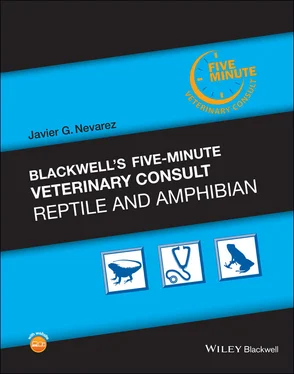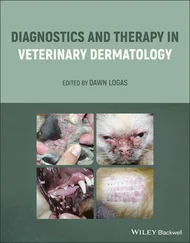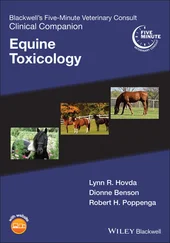Javier G. Nevarez - Blackwell's Five-Minute Veterinary Consult - Reptile and Amphibian
Здесь есть возможность читать онлайн «Javier G. Nevarez - Blackwell's Five-Minute Veterinary Consult - Reptile and Amphibian» — ознакомительный отрывок электронной книги совершенно бесплатно, а после прочтения отрывка купить полную версию. В некоторых случаях можно слушать аудио, скачать через торрент в формате fb2 и присутствует краткое содержание. Жанр: unrecognised, на английском языке. Описание произведения, (предисловие) а так же отзывы посетителей доступны на портале библиотеки ЛибКат.
- Название:Blackwell's Five-Minute Veterinary Consult: Reptile and Amphibian
- Автор:
- Жанр:
- Год:неизвестен
- ISBN:нет данных
- Рейтинг книги:4 / 5. Голосов: 1
-
Избранное:Добавить в избранное
- Отзывы:
-
Ваша оценка:
- 80
- 1
- 2
- 3
- 4
- 5
Blackwell's Five-Minute Veterinary Consult: Reptile and Amphibian: краткое содержание, описание и аннотация
Предлагаем к чтению аннотацию, описание, краткое содержание или предисловие (зависит от того, что написал сам автор книги «Blackwell's Five-Minute Veterinary Consult: Reptile and Amphibian»). Если вы не нашли необходимую информацию о книге — напишите в комментариях, мы постараемся отыскать её.
STAY UP TO DATE ON THE BEST PRACTICES FOR TREATING COMMON DISEASES IN REPTILES AND AMPHIBIANS Blackwell’s Five-Minute Veterinary Consult: Reptile and Amphibian
Blackwell’s Five-Minute Veterinary Consult: Reptile and Amphibian
Blackwell's Five-Minute Veterinary Consult: Reptile and Amphibian — читать онлайн ознакомительный отрывок
Ниже представлен текст книги, разбитый по страницам. Система сохранения места последней прочитанной страницы, позволяет с удобством читать онлайн бесплатно книгу «Blackwell's Five-Minute Veterinary Consult: Reptile and Amphibian», без необходимости каждый раз заново искать на чём Вы остановились. Поставьте закладку, и сможете в любой момент перейти на страницу, на которой закончили чтение.
Интервал:
Закладка:
The order Gymnophiona includes caecilians, which are a lesser known and studied group with over 200 species. Caecilians resemble earthworms and have reduced or absent eyes and limbs. There are both aquatic and terrestrial species that are mostly found in tropical lowlands. New world species are primarily viviparous while those from the old‐world are oviparous.
METABOLISM
When housed in captivity, providing an appropriate temperature and thermal gradient is critical for amphibian health. Amphibians may show a variety of clinical signs at extreme temperatures (Figure 2– see web image supplementary content for section I).
Amphibians are sensitive to desiccation and have developed techniques for regulating body temperature and retaining moisture. Changes in posture, locomotion, and skin color can be used to regulate temperature. Cooling can be accomplished by standing away from the ground and changing to a pale body color to decrease heat absorption. Peripheral vasodilation or constriction can also regulate the rate at which they dissipate or absorb heat. Some amphibians, anurans in particular, can produce glandular secretions that allow them cover part of their bodies in a waxy substance to protect against desiccation. These secretions are usually limited to the dorsal skin only, as ventral skin must remain thin to allow water uptake via the pelvic drink patch. Up to 80% of the total water uptake may occur through this pelvic patch. Dried mucus may also be used to cover the skin. Finally, they have iridophores that provide high skin reflectivity near the infrared spectrum (700–900 μm) to decrease solar heat exposure.
Some amphibians have developed specialized methods for surviving cold temperatures through a technique known as super cooling. Super cooling lowers the freezing point of tissues through a combination of physiological adaptations: Higher amount of fibrinogen, glucose‐transporting proteins and ice‐nucleating proteins in blood, low molecular weight carbohydrates (glycerol or glucose) in blood and tissues, and increasing plasma osmolarity by dehydration. These adaptations also promote ice growth in extracellular compartments while sparing the cells. In addition, they have good anoxia tolerance for freeze‐induced ischemia.
ANATOMY
Anurans can range from 1 cm to 30 cm in length and have glandular skin that may be smooth or have protuberances. Adults lack gills and claws are absent except in Xenopus sp. While anurans lack tails, frogs in the genus Ascaphus are referred to as tailed frogs due to the presence of a cloacal protrusion resembling a tail, which is actually an organ used by the males for copulation and internal fertilization.
Salamanders range from 4 cm to 1.5 m in length, have glandular skin and lack claws. Most have four legs except sirens, which lack pelvic limbs.
Caecilians range from 7.5 cm to 75 cm in length and lack limbs. A short tail is present in some species. A unique feature is the presence of small olfactory and sensory tentacles in the nasolabial groove.
Skeleton
| Order | Features |
|---|---|
| Anurans | 4 legs with 4 toes on the front and 5 toes on the back |
| Fused vertebrae—presacral, sacral, postsacral | |
| Lack sacrum | |
| Pelvic girdle is fused | |
| Forelimb—scapula, humerus, radioulnar joint, carpals, metacarpals, phalanges | |
| Hind limb—femur, tibiofibular joints, tarsals, metatarsal, phalanges | |
| Urostyle—fused caudal vertebrae | |
| Caudata | 4 legs but hind reduced in mud eels and missing in sirens |
| 4 toes on the front and 5 toes on the back | |
| Capable of limb and toe regeneration | |
| Tail autotomy | |
| Caecilians | Lack pectoral/pelvic girdle and sacrum |
CARDIOVASCULAR
Amphibians have a three‐chambered heart with two atria and one ventricle. There is an interatrial septum that is complete in anurans but fenestrated in caecilians and most salamanders. This septum may allow for some mixture of oxygenated and deoxygenated blood. A renal portal system is also present. A unique adaptation of amphibians is the presence of an extensive lymphatic system with lymph hearts, lymph sac dilations surrounded by muscle, which allows them to beat independently of the heart. The lymph hearts provide unidirectional flow of lymph to the heart and can beat at a rate of up to 60 beats/minute. The lymph contains all blood components except red cells.
VENIPUNCTURE SITES
Venipuncture can be challenging in many species but there are various sites where blood can be accessed. Sedation or anesthesia may be required to successfully collect blood, especially if attempting cardiac puncture. Venipuncture sites include the femoral vein, ventral abdominal vein, lingual vein/plexus, tail vein, maxillary/facial vein, musculocutaneous vein, and the heart.
IMMUNE SYSTEM
The blood of amphibians is composed of erythrocytes, thrombocytes, monocytes, lymphocytes, eosinophils, basophils, and neutrophils. Morphology of the white blood cells can be quite variable, so obtaining accurate white cell counts can be challenging when working with laboratories not familiar with their cell morphology. Their function is presumed to be similar to other species, but further research is still needed in this area.
Some amphibians lack a truly functional bone marrow, so hematopoiesis can occur in the spleen, liver, and kidneys, according to age and species. The spleen is composed of a red pulp responsible for erythropoiesis and white pulp responsible for myelopoiesis. The thymus produces T‐lymphocytes and is functional through life. The size of the spleen and thymus are affected by seasons, nutritional status, and stress. A well‐developed gut associated lymphoid tissue is present instead of lymph nodes.
RESPIRATORY SYSTEM
Amphibians have unique adaptations for respiration. In addition to traditional lung (pulmonic) respiration, they can also exchange gas via buccopharyngeal respiration, which allows exchange at the level of the oral and pharyngeal cavity. Cutaneous respiration may comprise up to 80% of the gas exchange, especially in aquatic species. Lateral folds, costal grooves, or cutaneous hairs may be present to increase surface area of the skin and improve the efficiency of cutaneous respiration. Finally, branchial/gill respiration occurs in juvenile stages and in neotenic species.
Amphibians have short tracheas with complete rings and single chambered lungs without alveoli. Instead there are a series of infoldings of the lungs that increase surface area. Lungs are absent in Plethodontidae and reduced or absent in the Hynobiidae.
Anuran larvae have small, simple gills covered by an operculum similar to fish. In contrast, salamander larvae have external gills without an operculum. The gills of caecilians are resorbed before birth/hatch. In anurans, they are resorbed during stages of metamorphosis. Salamanders resorb their gills during metamorphosis but they are retained in neotenic species.
INTESTINAL TRACT
The majority of adult amphibians are carnivores, but larvae may be herbivores. Sirens may also remain omnivorous into adulthood. Caecilians rely on olfaction to find prey while anurans and urodeles rely primarily on sight. Amphibians have jointed pediceled teeth in which the crown is loosely attached to the base (pedicel) of the tooth. The tooth itself attaches to the jaw. Teeth are used for holding prey in place rather than chewing, so they are often angled backward toward the pharynx. Teeth are shed and replaced through life. There are one or two rows of maxillary and mandibular teeth in most species. However, ranid frogs lack mandibular teeth and bufonid toads have no teeth. Anurans and salamanders have well‐developed moveable tongues commonly used for prey apprehension. Caecilians have fixed tongues. Frogs in the family Pipidae (clawed frogs and Surinam toads) lack tongues and vocal cords.
Читать дальшеИнтервал:
Закладка:
Похожие книги на «Blackwell's Five-Minute Veterinary Consult: Reptile and Amphibian»
Представляем Вашему вниманию похожие книги на «Blackwell's Five-Minute Veterinary Consult: Reptile and Amphibian» списком для выбора. Мы отобрали схожую по названию и смыслу литературу в надежде предоставить читателям больше вариантов отыскать новые, интересные, ещё непрочитанные произведения.
Обсуждение, отзывы о книге «Blackwell's Five-Minute Veterinary Consult: Reptile and Amphibian» и просто собственные мнения читателей. Оставьте ваши комментарии, напишите, что Вы думаете о произведении, его смысле или главных героях. Укажите что конкретно понравилось, а что нет, и почему Вы так считаете.












